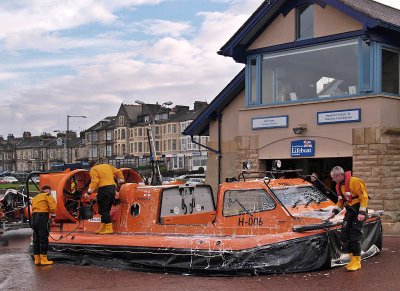But in fact, this isn't an unusual sight if your walk is along the seafront at Morecambe, Lancashire, because there the Royal National Lifeboat Institution (RNLI) rescue vehicle of choice is an 8 metre, 2.4 tonnes hovercraft with a top speed of 30 knots. Morecambe is one of only four RNLI stations in Britain to use a hovercraft alongside a more conventional boat. The shallow waters and treacherous sands of the Bay make it the ideal rescue craft when the tide is out, and often when it is in too.
I suppose it's fair to say that the hovercraft has never quite fulfilled the promise that the British inventor Christopher Cockerell saw for it. As a mainstream form of transport probably its finest hour was in the form of the SRN 4s that competed for many years with the traditional ferries on the English Channel route. But elsewhere it has been a niche vehicle, used as an inshore patrol vessel by various armed forces, as a high-speed but low volume ferry, and for recreational purposes. On over-water routes hydrofoils and jetfoils have largely taken its place, bringing not just lower running costs but, crucially, less noise for passengers and everyone else! Whatever the merits of the hovercraft they are really noisy.
I took this photograph on a dull, cold day, the only brightness around being the orange of the hovercraft and yellow of the crew's clothing. Out of the camera the shot was flat, so I had to do quite a bit of post processing to rescue a barely serviceable image of this very serviceable rescue craft!
photograph & text (c) T. Boughen
